
The rupiah is the official currency of Indonesia, issued and controlled by Bank Indonesia. Its name is derived from the Sanskrit word for silver, rupyakam (रूप्यकम्). Sometimes, Indonesians also informally use the word perak in referring to rupiah in coins. The rupiah is divided into 100 cents, although high inflation has rendered all coins and banknotes denominated in cents obsolete.

Philippine peso coins are issued by the Bangko Sentral ng Pilipinas for circulation in the Philippines and are currently available in seven denominations. The Philippine peso has been in use since Spanish rule.

Nias is an island located off the western coast of Sumatra, Indonesia. Nias is also the name of the archipelago of which the island is the centre, but also includes the Batu Islands to the south-east and the small Hinako Islands to the west. Nias Island covers an area of 5,625.0 km2 (2,171.8 sq mi). It is mostly a lowland area rising to around 800 m (2,600 ft) above sea level. There were 756,338 inhabitants on the island at the 2010 Census; at the 2015 Intermediate Census this had risen to 798,506 and the 2020 Census resulted in a total of 880,550. The official estimate as at mid 2022 was 902,632.
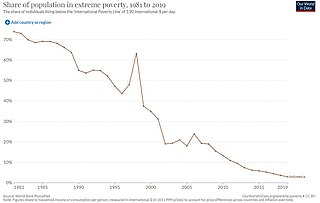
Poverty in Indonesia is a widespread issue though in recent years the official numbers show a declining trend. Due to the dense rural nature of parts of the Java, Bali, Lombok, and parts of Sumatra, poverty can be classified into rural and urban poverty. Urban poverty is prevalent in not only in Jabodetabek, but also in Medan and Surabaya.

The first coins of the Indonesian rupiah were issued in 1951 and 1952, a year or so later than the first Indonesian rupiah banknotes printed, following the peace treaty with the Netherlands in November 1949. Although revolutionary currency had been issued by the provisional Indonesian government between 1945 and 1949, it had all been formed of paper, for metal were too scarce for the internationally isolated government to use as currency.
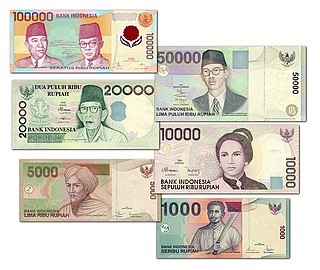
The first banknotes used in the archipelago that would become Indonesia were those issued by the United East India Company, credit letters of the rijksdaalder dating between 1783 and 1811. Netherlands Indies gulden government credit paper followed in 1815, and from 1827 to 1842 and again from 1866 to 1948 gulden notes of De Javasche Bank. Lower denominations were issued by the government in 1919–1920 and in 1939–1940 due to wartime metal shortages, but otherwise day-to-day transactions were conducted using coinage.
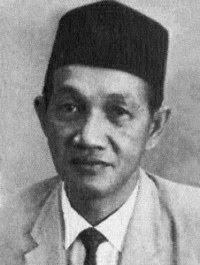
Idham Chalid was an Indonesian politician, religious leader, and minister, who served as Chairman of the People's Consultative Assembly and Chairman of the People's Representative Council from 1972 until 1977. He was also a prominent leader of the Nahdlatul Ulama (NU) and leader of the United Development Party (PPP), from 1956 until 1984.

The Indian 10-rupee coin is a denomination of the Indian rupee. The ₹10 coin is the second highest-denomination coin minted in India since its introduction in 2005. The present ₹10 coin in circulation is from the 2019 design. However, the previous ₹10 coins minted before 2019 are also legal tender in India. All ₹10 coins containing with and without the rupee currency sign are legal tender, as stated by the Reserve Bank of India. Along with the standard designs, there are 4 different designs for this denomination and this is used alongside the 10 rupee banknote.
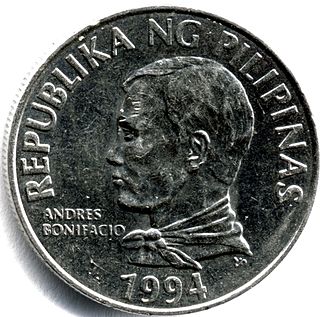
The Philippine two-peso coin (₱2) was a denomination of Philippine currency. It was minted by the Bangko Sentral ng Pilipinas from 1983 to 1994 and was demonetized in 1998.

The Philippine fifty-centavo coin (50¢) was a denomination of Philippine currency. It was minted for the Philippines from 1864 to 1994 and was demonetized in 1998.
This is a list of emblems or coat of arms used in Indonesia. Indonesia is divided into 38 provinces, and each province is divided into regencies (kabupaten) and cities (kota). There are 416 regencies and 98 cities. Each province, regency, and city has its own emblem.

PT Bank Pembangunan Daerah Kalimantan Timur dan Kalimantan Utara, doing business as Bankaltimtara, is an Indonesian regional development bank serving East Kalimantan and North Kalimantan. It was previously known as Bank Kaltim or East Kalimantan Bank until 2017 when the company was renamed after new North Kalimantan province was created. It is also one of the biggest compared to other province's regional development banks in Indonesia.

The Indonesian one thousand rupiah coin (Rp1,000) is a coin of the Indonesian rupiah. It circulates alongside the 1,000-rupiah banknote. First introduced on 8 March 1993 as bimetallic coins, they are now minted as unimetallic coins, with the first of its kind appearing in 2010 and its latest revision being in 2016. As of 2024, the last two series in this denomination are legal tender.
Ciomas is a kecamatan in Bogor Regency, West Java, Indonesia. It is located near the provincial border with Banten, about 21 kilometers southwest of the regency capital Cibinong, and 3 kilometers west of the city center of Bogor. It borders Bogor Barat in the north, Bogor Selatan in the east, Tamansari in the south, and Dramaga in the west. In 2021, Ciomas has a total population of 172,336.

The Indonesian two hundred rupiah coin (Rp200) is a coin of the Indonesian rupiah. It was first introduced in 2003 and was revised in its current form on December 19, 2016.

The Indonesian two thousand rupiah banknote (Rp2,000) is a denomination of the Indonesian rupiah. First introduced on July 9, 2009, it was made legal tender the following day and has since been modified two times, first in 2016 and then in 2022. All notes of this denomination are printed in cotton paper since its inception.

The Indonesian twenty five rupiah coin (Rp25) is a now-defunct denomination of the Indonesian rupiah. It was introduced in 1971 and was last revised in 1991. Coins of this denomination were minted until 1996 and have been invalid for transactions since August 31, 2010 when the 1991-issue Rp25 coin ceased to be legal tender.

The Indonesian five hundred rupiah coin (Rp500) is a denomination of the Indonesian rupiah. It was introduced in 1991 and has since been revised three times in 1997, 2003, and 2016. It currently has the second-highest value of all circulating rupiah coins after the Rp1,000 coin. As of December 2023, only alumunium 500 rupiah coins, dated 2003 and 2016, are legal tender.

The Indonesian one hundred rupiah coin (Rp100) is a denomination of the Indonesian rupiah. First introduced in 1973 in cupronickel, it has been revised four times throughout its history, changing materials in 1991 and 1999. As of 2022, it is the second-lowest valued coin of the rupiah after the now-rarely encountered Rp50 coin.
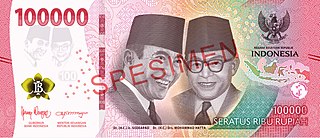
The Indonesian one hundred thousand rupiah banknote (Rp100,000) is a denomination of the Indonesian rupiah. Being the highest and second-newest denomination of the rupiah, it was first introduced on November 1, 1999, as a polymer banknote before switching to cotton paper in 2004; all notes have been printed using the latter ever since.






















